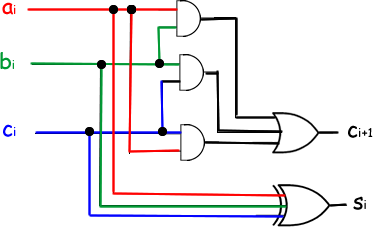Lets start with the LSB - least significant bit.
a0 |
b0 |
s0 |
0 |
0 |
0 |
0 |
1 |
1 |
1 |
0 |
1 |
1 |
1 |
0 |
The one bit adder does just that - adds two single bit values together.
The 'c' column is a 'carry' column.
When we add 01 and 01 we get 10 - that single bit value is zero - but we have to carry a value on to the next column.
The S0 output can be seen to be XOR (only high if a or b is high - not if both are high or both are low.
s0 = a0 XOR b0
C1 output can be seen to be high only when a and b are high so it is an AND relationship. We can now look at the second, and subsequent, columns - but this time there is a 'c' column to take into account too... as we might have to 'carry' a value.
| |
a3 |
a2 |
a1 |
a0 |
|
b3 |
b2 |
b1 |
b0 |
+ |
c3 |
c2 |
c1 |
|
| |
s3 |
s2 |
s1 |
s0 |
This time we have the possibility of a carry-bit from the addition of the LSB column.
a1 |
b1 |
c1 |
s1 |
0 |
0 |
0 |
0 |
0 |
1 |
0 |
1 |
1 |
0 |
0 |
1 |
1 |
1 |
0 |
0 |
0 |
0 |
1 |
1 |
0 |
1 |
1 |
0 |
1 |
0 |
1 |
0 |
1 |
1 |
1 |
1 |
s1 = XOR (aibici) - XOR is high if number of inputs is odd.
This can be applied to any line of the truth table... so if we replace the number of the bit-line we are examining with 'i' we get:
We can now draw a logic gate diagram for the adder.

The truth table and the logic gate diagram uses 'i' and 'i+1' etc to be 'general'. You could therefore do any level you were asked to.
For example if 'i' was 3 the values would be:
s3 = XOR(a3,b3,c3)